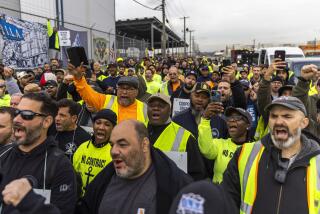Eyeing Vancouver Port Unrest
- Share via
To avoid a repeat of a strike that idled Canada’s busiest port for five weeks last summer, officials in Vancouver have borrowed a strategy pioneered in Southern California: extending the hours that terminal gates are open.
The idea is to keep truckers happy by reducing congestion so that drivers can make better money hauling even more steel containers crammed with imported goods.
But so far, Vancouver has found the extended hours to be a tough sell. And in Southern California, where truckers are similarly unhappy over working conditions but have failed to mount an organized response, Vancouver’s labor unrest is being watched with great interest.
“Vancouver is a living model that could make other truckers think seriously about using that model,” said Harley Shaiken, a UC Berkeley professor who specializes in labor issues.
Last July, Southern California’s two big harbors did something unprecedented at U.S. ports. The 14 cargo container terminals at the neighboring Los Angeles and Long Beach ports added regular night and Saturday hours so that truckers could pick up freight.
The extended hours were immediately embraced by importers, who were slapped with a surcharge for moving cargo during peak traffic periods. Off-peak truck traffic at the nation’s largest port complex accounted for 34% of total cargo moved in March, up from 12% to 15% moved by special arrangement previously, according to PierPass, the nonprofit entity created to run the after-hours program.
But truckers at the Los Angeles-Long Beach port complex don’t like the extended hours. Port truckers complain that extended terminal hours in Los Angeles and Long Beach mean extra pay for unionized employees working at night, including clerks and longshoremen, but not for the drivers, who say they are spending longer hours behind the wheel. Most of the port drivers don’t belong to a union -- a rally protesting the July launch drew one trucker -- and their complaints haven’t produced any action.
“Vancouver has been a real big interest to us,” said Chuck Mack, ports division director of the International Brotherhood of Teamsters, which represents some port truckers. “To be able to hold out as long as they did and maintain that solidarity, you don’t see that oftentimes with organized workers today.”
Don Snyder, director of trade and maritime services for the Port of Long Beach, said a trucker strike in Southern California “would affect all kinds of things, local deliveries to distribution centers and a good portion of the rail cargo that is trucked to inland rail yards. It would be a mess.”
Unlike the Southern California ports, Vancouver is slowly phasing in the longer terminal hours. The port’s three container terminals have been open from 4 p.m. to midnight on Thursdays and from 8 a.m. to 4 p.m. on Saturdays since January. The port plans to add a night each year.
The initial effort has fallen short of the 20% off-peak traffic target set by port officials. The program in the British Columbia city differs from Southern California’s in that importers aren’t penalized for moving cargo during peak hours of operation and the extended hours are still very limited.
“The response has been less than overwhelming,” said Duncan Wilson, manager of government relations for the Vancouver Port Authority, which last year handled the equivalent of nearly 1.9 million 20-foot shipping containers, ranking it among the busiest in North America.
Longer terminal hours are part of Vancouver’s efforts to prevent a repeat of last summer’s debilitating work stoppage.
On June 27, about 1,200 truckers calling themselves the Vancouver Container Truck Assn. -- representing slightly less than half of the driver pool that worked the docks in southwest British Columbia -- refused to pick up cargo.
They didn’t go back to work until August, when government officials decided to temporarily suspend that nation’s antitrust laws that forbid the drivers, who are considered independent operators, from joining together to negotiate better pay.
By then, containers had piled up on the docks by the tens of thousands.
“Fish plants were laying off people. Sawmills were shutting down. There were stores with nothing on the shelves,” said Anne McMullin, spokeswoman for the Vancouver Port Authority.
A government task force later determined that the trucking firms that hired the drivers had failed to negotiate sufficient payments from shipping lines and importers.
In addition to the extended terminal gate hours, the task force recommended requiring reservations to prevent large numbers of drivers from bunching up for hours-long waits to take containers to and from the ports.
Since the strike, drivers have been flocking to a newly created local of the 250,000-member Canadian Auto Workers Union, which has been negotiating standard union contracts with trucking companies that guarantee rates that are the equivalent of about $80 per loaded container. The average Southern California port driver makes $50 to $60 for the same job.
“I wanted rates adjusted in a way that really compensates me for my time. I am running a business here,” said 43-year-old Malkit Sidhu, a Vancouver resident and port driver who said he grossed about $60,000 during the last 12 months but cleared less than $20,000 for his wife and two children after taxes, fees and maintenance on his truck.
Vancouver is keeping its collective fingers crossed, fearing permanent damage to its reputation as a world trade gateway.
“The hope is that it brings about stability, long-term stability. We cannot have the kinds of threats and job actions that we had last year. It has the potential of crippling the economy,” said the Vancouver Port Authority’s McMullin.
More to Read
Sign up for Essential California
The most important California stories and recommendations in your inbox every morning.
You may occasionally receive promotional content from the Los Angeles Times.











